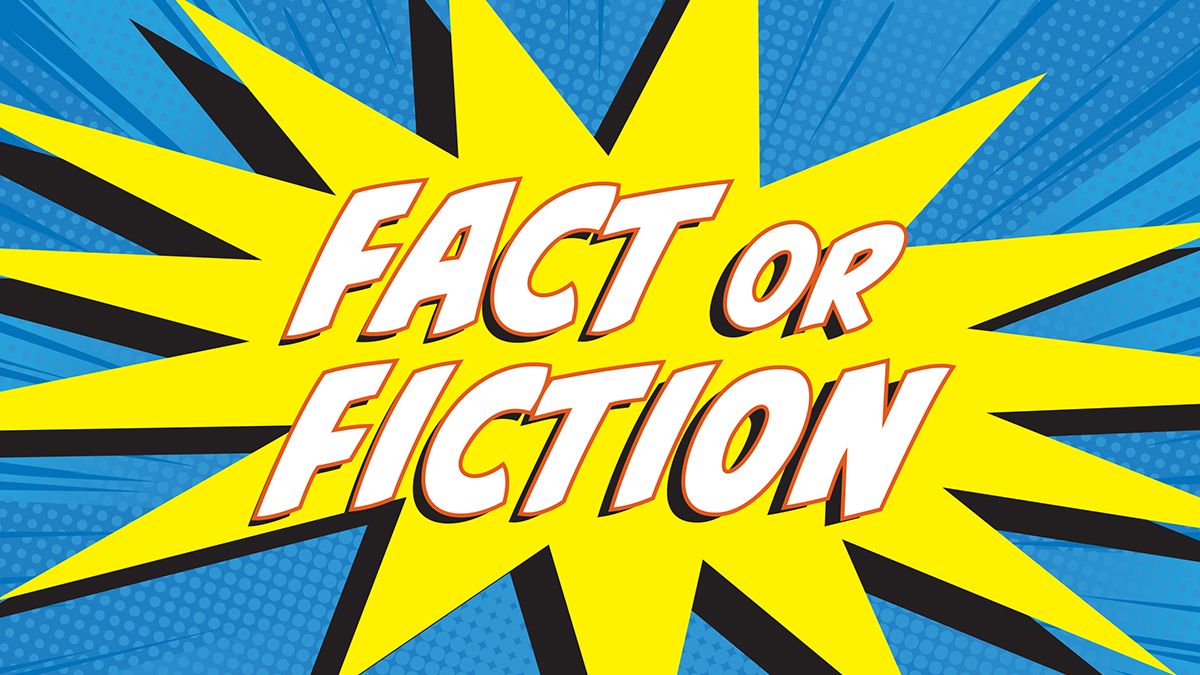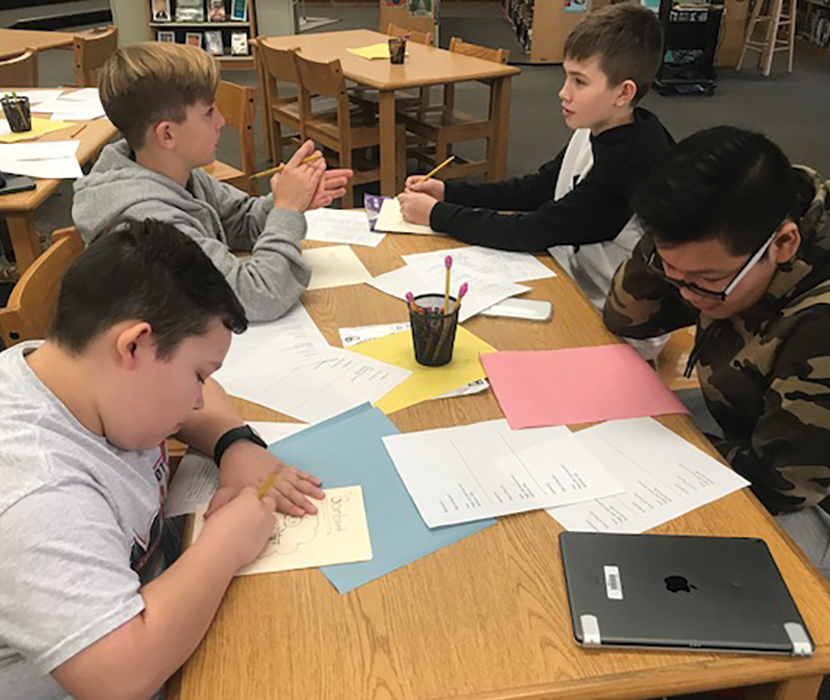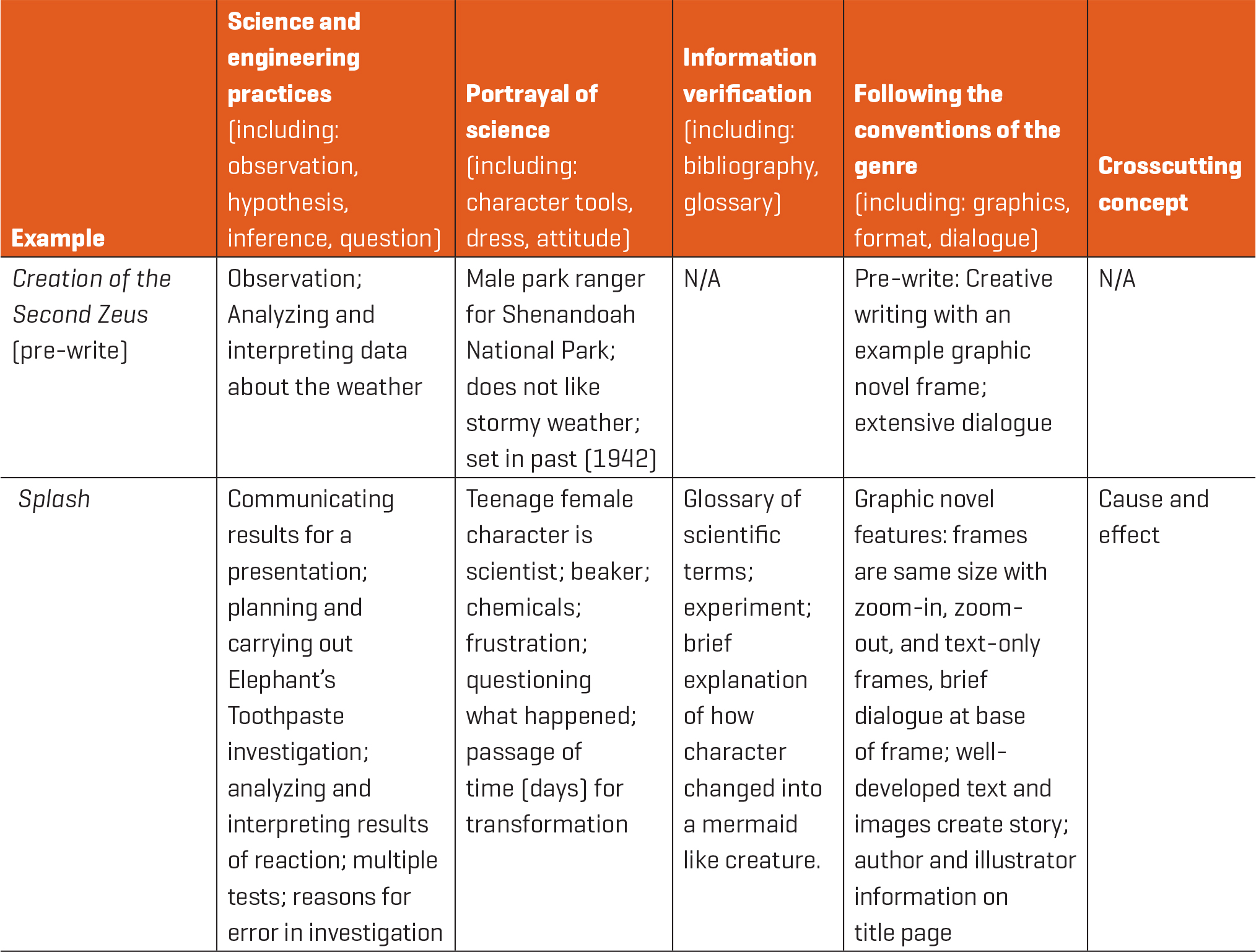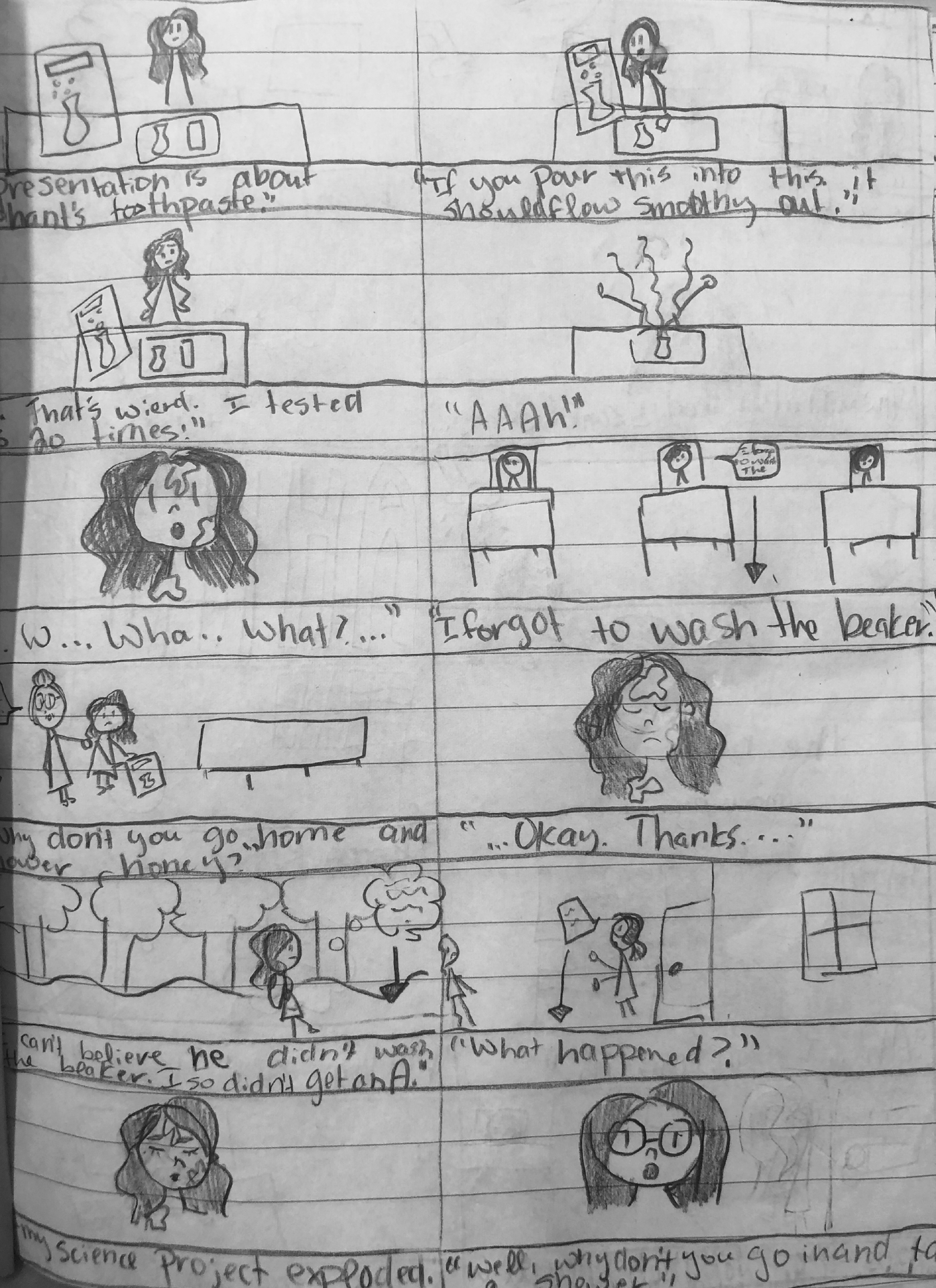feature
Fact or Fiction
Developing Graphic Novels for Science
Science Scope—November/December 2020 (Volume 44, Issue 2)
By Krista L. Adams, Emily L. Zuccaro and Jilliane R. McCardle

Graphic novels are an emerging genre and instructional tool in K–12 classrooms today. The genre combines images and text told through panels or frames and is often compared with a comic in a longer format. Graphic novels draw on multimodal methods, or use more than one mode of communication, which according to Boerman-Cornell (2016), “give[s] readers many layers of meaning making” (p. 328). The reader must make sense of both text and images, as well as the storytelling, making it a more complex reading experience. Research on the use of graphic novels in English language arts (ELA) classrooms has also shown that graphic novels support English language learners as well as special education students.
Graphic novels based in a field of science use the platform to teach science facts explicitly, to describe a biography of a scientist (e.g., Jane Goodall), or to tell a story with science implicitly woven through the narrative (see Resource section for graphic novel resources). Additionally, these science-specific graphic novels include various text features (e.g., glossary, author notes), which are found in many nonfiction and informational texts. These features serve to help readers evaluate a book’s accuracy (Bamford and Kristo 2000) as they learn how writers of nonfiction think and work (Wilson 2006). As such, we used these graphic novels as mentor texts—texts that serve as exemplars for students to identify key features and practices of the genre.
Our goal for this creative writing project was to explore how middle school students represented science through their creation of a graphic novel. The project proved to be an opportunity for collaboration to explore our intersecting teaching interests related to literature and science. We worked with 12 sixth-grade gifted and talented enrichment groups that met in the library one day a week for 45 minutes. Our intention was to develop a differentiated project that could be used across multiple courses (e.g., science, English language arts), abilities, and grade levels. Though introduced in an enrichment class, the science teacher may choose to collaborate with the ELA teacher to integrate this project in both courses to support science and ELA.
For the majority of the project, students exercised their autonomy to represent any science content bounded (or not) by scientific theories and laws. For example, gamers are aware when a video game depicts objects that do not obey Newton’s law of gravitation. Similar to video games, students must set the rules and decide how to leverage them to accomplish the objective of their story (Gee 2004), while balancing the precision of scientific ideas. With the emphasis on exploring and evaluating information, our class regularly met in the library. For this activity, we gave students the opportunity to explore and evaluate science concepts that were of interest to the individual student. Aligning with the school’s core competencies, students were then asked to analyze their creations using multiple perspectives, which include scientific concepts, processes, skills, and crosscutting concepts. The teacher may need to reserve the library space or computer lab to support students in conducting research. Next, we describe how we implemented the graphic novel project with this group of sixth-grade students.
Day 1
On our first day, we used our 45-minute lesson to determine students’ ideas about graphic novels. The students expressed great excitement when they learned they would be developing a graphic novel over the next seven class meetings. We started the class with the students randomly divided into groups of four to discuss one of three questions (see Figure 1). To initiate discussion, we prompted students to define the features of a graphic novel, how graphic novels fit in science classrooms, and how an individual could learn science through a graphic novel. After 10 to 15 minutes, each group shared their responses, and the other groups were encouraged to share any additional ideas after each presentation. Initially, the groups only had a few ideas about graphic novels—mostly science fiction—and they had not used graphic novels in the science classroom. Graphic novels, to these students, were typically fictional or nonfictional books that depicted a series of events. Students named Miss Frizzle and The Magic School Bus created by J. Cole (see Resources) as a familiar science graphic novel. While we acknowledge it is not an accurate description, we used it as an instructional tool for further exploring the integration of science into storylines. Students also believed that graphic novels would most likely show how science—Earth and space science, specifically—works. When we questioned students about why they only mentioned Earth and space science, the group added additional areas of science such as chemistry, botany, archaeology, and biology.
Students’ ideas about graphic novels and science.
|
What are graphic novels? |
How do graphic novels fit into a science classroom? |
How can we learn science through graphic novels? |
|
Superheroes, action, dialogue, sometimes fiction, graphic novels go to movies or movies go to graphic novels, extra-long picture, books, sci-fi, nonfiction, illustrated chapter books, long comics, sequence of events (i.e., Big Bang), sound noises |
Mix fiction with nonfiction, teach science lessons in graphic novels, Miss Frizzle, use the power of science to overcome unlikely sci-fi situation |
Analyze/understand how science works—first listed Earth and space science when prompted, added chemistry, botany, archaeology, biology
|
Days 2 and 3
These two class meetings were designed to allow students to understand the project and prewrite a storyline for their individual graphic novel. The first 15 minutes of class began by going over the graphic novel rubric for establishing guidelines (see graphic novel rubric in Online Supplemental Materials). The students were then encouraged to develop the storyline in narrative form, but they were also allowed to draw a few image frames during this stage. Students’ initial ideas ranged from (1) a few children around the world survived a zombie virus and had to determine a cure to save the rest of humanity; (2) a group of students developed a series of connecting graphic novels similar to the Marvel universe created by Stan Lee and his colleagues; and (3) the mystical magician. Using instructional scaffolding strategies such as encouraging student choice in topic selection, activating their prior scientific knowledge, and promoting the use of science specific vocabulary empowered students to take ownership of this experience and create graphic novels that were original and informative and creative.
On the third day, we spent the entire class instruction period speaking with each student about their storyline idea. We engaged in student-driven conversations about their ideas and narrowing their focus. Many of them had inadvertently left off key details to support and explain the science grounding their stories. As such, we asked them to share what science concept they thought might align with their story and to research the concept. For example, one student decided that her main character would suddenly become a mermaid because of a chemical change that had mistakenly taken place. As they began their research, we discussed and provided students with a form to collect references for their project (see science graphic novel bibliography template in Online Supplemental Materials). By regularly meeting in the library, we worked with students to find appropriate informational texts, encouraged students to use computers and tablets with internet access, and provided the mentor texts for the students to explore their ideas. At the end of class, the students were charged with continuing to gather science ideas for their stories.
Days 4–7
We emphasized supporting students in shifting from the prewriting narrative form to the graphic novel format for the final days of this project. Day 4 involved the students going over their drafts and identifying places where they would insert factual science content to support and enhance their novels. Our instruction emphasized how to weave science content and/or processes in thorough, developed, and accurate ways using mentor texts to create connections. We reviewed the mentor texts for two focus areas: the connections between the dialogue and images, and other key text features that supported the science within the story (e.g., glossaries, preface, conclusions). We noticed students chose to use the mentor texts primarily for example text features rather than storyline development. Notably, even with the science-specific mentor texts available, the students chose to create graphic novels that followed a fictional storyline. We would expect their products to be more science-content specific if this project were embedded in a particular science unit, such as physics or astronomy.
At the next class meeting, the students spent the majority of their time together engaging in peer-editing conversations. Working in groups of four, students were able to discuss their drafts while their peers took turns writing feedback on sticky notes, asking questions, and listening (see Figure 2). This time allowed students to flesh out their graphics while other students focused on the text and organizational components that would become their graphic novels. It was evident that students were grappling with this idea of shifting their focus from a traditional writing format to a graphic novel format. For example, one student was apprehensive to move beyond the traditional creative writing format in which he had drafted his initial story. While the student and the gifted coordinator looked over the mentor texts together, the conversation focused on how to adapt his story to fit the graphic novel format. We identified that the focus was sometimes on the image and not necessarily on the text.

Peer editing conversations.
Prior to turning in their graphic novel, students were asked to identify the crosscutting concept (CCC) for their project. The school expressed particular interest in this practice in order to help students make connections to how concepts are aligned across disciplines. We began by going over each CCC and asking students for definitions or examples. Some CCCs were easier for the students to create examples for (e.g., patterns, matter and energy, cause and effect). The students were unsure of what stability and change might refer to. We used the example of the metamorphosis of a butterfly to understand this CCC. Finally, we provided students with a description of the CCC using the National Science Teaching Association’s crosscutting concepts webpage (NSTA n.d.). As they began to analyze their graphic novel, we reminded students that they could use more than one CCC. This was important, as a few students did identify more than one for their graphic novel. Ultimately, students will use this skill in the mainstream science class to support the school’s core competencies for analyzing the scientific endeavor.
Assessing the graphic novels
We set out to examine how the students wove science content and/or practices into a graphic novel. This involved assessing the images, dialogue, references, and additional descriptions provided within the graphic novel. To begin our analysis, we developed an additional scoring guide to assess the detail and accuracy categories (see Figure 3). The detail category looks at the attributes of science and engineering practices along with the amount of information about the content and/or science and engineering practices within the graphic novel as a whole. We discovered that the project showcased students’ understanding of the nature of science through applied science and engineering practices.

Students’ graphic novel examples.
Beyond the science content and practices, we assessed the elements of a graphic novel such as image placement, dialogue development, and the storyline. We used a rubric to determine the use of images, graphic novel characteristics, level of detail, and accuracy (see graphic novel rubric in Online Supplemental Materials). Although the graphic novel images were simplistic, the students used various science and medical equipment, symbols, and processes to add a robustness to the narrative (see example of graphic novel page in Figure 4). We observed formatting pictures and dialogue as a challenge for students when implementing the project, and we were encouraged by the students’ ability to draw on their creativity as they worked, shifting creative writing to graphic novel features. Students were successful in finding ways in which to support the fictional narrative with science ideas.

Splash: A graphic novel exploring chemical reactions.
Reflection
We set out to examine how the students integrated science content and/or practices within a graphic novel. The mentor texts proved to be an invaluable resource for the students to experiment with detail and accuracy. Many students chose to include both a glossary and author notes to provide an additional explanation for the science behind the story. These features allowed us to evaluate the students’ understanding of the scientific concept. Although we encouraged the use of references, we only had a few students include this feature. When implementing this project in the future, we would require students to add references to support the level of accuracy.
Students surprised us by highlighting the process of science in ways that are not found in typical laboratory write-ups and open-response questions. The creative writing project allowed the students to capture that science is a human endeavor with the requisite curiosity in asking questions, as well as the ingenuity to determine how the fictional results fit into the current scientific understandings—much like science fiction novelists. In addition, the project presented the humanness of science with the necessary emotions associated with the struggles and triumphs. Moving forward, we would plan more lessons on how to draw on meaning in images as well as weave more science content into their product. Ultimately, the project would serve well for a culminating project for a unit or school year.
Conclusion
We believe the emphasis on text and images provides a unique window into the world of science. The graphic novel project afforded students the opportunity to explore not only the knowledge, skills, and practices of science, but also what science is and how science works through writing. Graphic novels are a sophisticated instructional tool in science classrooms and provide exciting opportunities for collaboration between science and ELA classroom teachers.
Resources
Cole, J. 1997. The magic school bus and the electric field trip. New York, NY: Scholastic.
Cunningham, D. How to fake a moon landing. New York, NY: Abrams ComicArts.
Ottaviani, J. 2009. T minus, the race to the moon. New York, NY: Simon & Schuster.
Ottaviani, J. 2011. Feynman. New York, NY: First Second.
Ottaviani, J. 2013. Primates: The fearless science of Jane Goodall, Dian Fossey, and Biruté Galdikas. New York, NY: First Second.
Ottaviani, J. 2016. The imitation game, Alan Turing decoded. New York, NY: Abrams ComicArts.
Ottaviani, J. 2019. Hawking. New York, NY: First Second.
Wicks, M. 2015. Human Body Theater: A non-fiction revue. New York, NY: First Second.
Online Supplemental Materials
Instructional Materials Interdisciplinary Literacy Middle School


